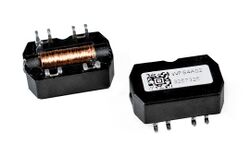Physics:Wiegand Sensor
Wiegand sensors are magnetic sensors that do not need any external voltage or current, and make use of the Wiegand effect to generate a consistent pulse every time magnetic field polarity reverses. Wiegand sensors are made by wrapping a coil around a Vicalloy wire core, which, due to the hysteresis inherent in the Wiegand effect, induces a pulse in the coil each time the magnetic polarity of the Vicalloy wire core reverses.[1] They can be used in a range of magnetic sensing applications and have the additional advantage that the energy of each pulse can be harvested.[2]
Energy harvesting
The consistency of the pulses produced by Wiegand sensors can also be used to provide energy for ultra-low power electronics to be operated using a single pulse. In addition, successive pulses can be stored to offset energy demand of low-power energy circuits. Alternatively, the pulses can be used to trigger, or ‘wake-up’, intermittently powered electronic circuits.[3]
In certain applications, both functions of the pulses (magnetic sensing and energy harvesting) are exploited. The pulse energy is used to power ultra-low power circuitry or ICs which, in turn, use the timing of the pulses to perform calculation tasks (e.g. count event data).[4]
Applications
Typical applications fall into three main categories; pulse generation applications, power transmission applications and combined sensing and energy harvesting applications.[2]
Pulse generation
As a reliable source of consistently timed pulses, Wiegand sensors are used in industrial and commercial flow-metering applications (e.g. water and gas), and also to calculate rotation speed in tachometers (e.g. high-speed trains).
Power transmission
By placing the Wiegand sensor within an oscillating electro-magnetic fields (e.g. from a Helmholtz coil), Wiegand sensors can be used to provide energy for low power applications in environments where high frequency transmission is challenging (e.g. transcutaneous power for medical devices).[5]
Sensing and energy harvesting
Wiegand sensors are commonly used in ‘Batteryless’ rotary encoder technology for self-powered revolution counting. Harnessing both the timing of the pulses and the pulse energy, such rotary encoders provide reliable multiturn counting even in the absence of external power or batteries.[6]
References
- ↑ "Google Scholar". https://scholar.google.com/scholar_lookup?title=Switchable+Magnetic+Device&author=Wiegand,+J.R.&publication_year=1981.
- ↑ Jump up to: 2.0 2.1 "Wiegand Sensors". https://www.posital.com/media/en/posital_media/documents/flyer_wiegand_sensor/wiegand_sensors.pdf.
- ↑ Saggini, Stefano; Ongaro, Fabio; Corradini, Luca; Affanni, Antonio (2015). "Low-Power Energy Harvesting Solutions for Wiegand Transducers". IEEE Journal of Emerging and Selected Topics in Power Electronics 3 (3): 766–779. doi:10.1109/JESTPE.2015.2424598. https://ieeexplore.ieee.org/document/7089155.
- ↑ Google Scholar. doi:10.1109/tmag.2017.2713837. https://scholar.google.com/scholar_lookup?title=Battery-less+hall+sensor+operated+by+energy+harvesting+from+a+single+Wiegand+pulse&author=Takemura,+Y.&author=Fujiyama,+N.&author=Takebuchi,+A.&author=Yamada,+T.&publication_year=2017&journal=IEEE+Trans.+Magn.&volume=53&pages=4002706&doi=10.1109/TMAG.2017.2713837. Retrieved 2020-05-12.
- ↑ "Circuit Parameters of a Receiver Coil Using a Wiegand Sensor for Wireless Power Transmission". https://www.researchgate.net/publication/333820360.
- ↑ "WHITE PAPER: Energy Harvesting with the Wiegand Effect". https://www.posital.com/media/posital_media/documents/flyer_wiegand_sensor/WiegandTech_WHITEPAPER_2018_002.pdf.
 |



